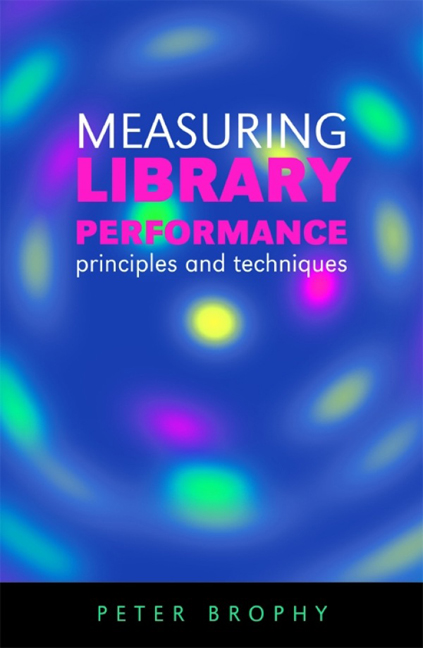Book contents
- Frontmatter
- Contents
- List of figures
- List of tables
- Preface
- Acronyms and abbreviations
- 1 Background
- 2 Theoretical considerations
- 3 User satisfaction
- 4 Impact on users
- 5 Social and economic impact
- 6 Inputs
- 7 Processes
- 8 Outputs
- 9 Staff
- 10 Infrastructure
- 11 Services for all
- 12 Benchmarking
- 13 The balanced scorecard
- 14 Standards
- Appendix 1 Data collection methods
- Appendix 2 The analysis of data
- Appendix 3 The presentation of results
- Index
- Frontmatter
- Contents
- List of figures
- List of tables
- Preface
- Acronyms and abbreviations
- 1 Background
- 2 Theoretical considerations
- 3 User satisfaction
- 4 Impact on users
- 5 Social and economic impact
- 6 Inputs
- 7 Processes
- 8 Outputs
- 9 Staff
- 10 Infrastructure
- 11 Services for all
- 12 Benchmarking
- 13 The balanced scorecard
- 14 Standards
- Appendix 1 Data collection methods
- Appendix 2 The analysis of data
- Appendix 3 The presentation of results
- Index
Summary
■ Introduction
While the importance of outcomes and impacts has been stressed in earlier chapters, it remains the case that assessing outputs is an important way of measuring performance. While bigger does not necessarily mean better, it is certainly true that the average reader is likely to find more of interest in a large library than in a small one – all other things being equal. Because a larger stock almost always means a more varied stock, the large library has an inbuilt advantage. Of course other factors are at play. We would want to ask how old the stock is. How well is it described in the catalogue? How readily can items be found on the shelves? How liberal are the lending policies? How helpful are the staff? Each of these issues will be reflected in the volume of business that the library transacts, so that measuring those outputs will be helpful as we seek to measure overall performance.
Outputs often feature prominently in libraries’ reports. The statistical summaries which were discussed in Chapter 6, ‘Inputs’, contained a considerable amount of data on outputs as well as inputs, not surprisingly since quantitative data are often reported as a whole. Although there is a huge range of potential outputs that could be counted, the most common ones that libraries report are volume of issues, which measures items that users have borrowed, and number of visits, which measures physical visits to library services; LISU calls these ‘the most prominent output measures’ (Creaser et al., 2005).
■ Usage of library materials Usage counts
The amount of usage of library materials is one of the most frequently measured outputs and this is often presented under the heading of ‘document delivery’. The performance of the library is assessed in relation to the number of items delivered during a specified time period, sometimes associated with factors such as delivery times. For example, the interlibrary loan (ILL) service may best be judged by a combination of its success rate in obtaining items requested by users and the speed with which it is able to arrange delivery of those items to them. Monitoring this activity regularly will be fundamental to assessment of the library's ongoing performance.
- Type
- Chapter
- Information
- Measuring Library Performanceprinciples and techniques, pp. 113 - 121Publisher: FacetPrint publication year: 2006



